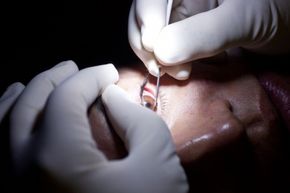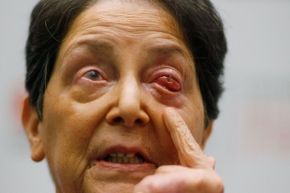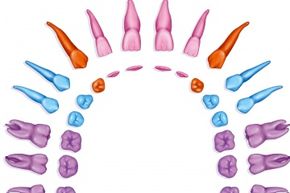Your eyes are one of nature's greatest evolutionary triumphs. With a few quick glances, humans can find food, perceive danger, steer a high-speed vehicle, locate mates, or, you know, sit on a couch and watch Netflix. But when your eyes are damaged by accident or disease, your world becomes infinitely more difficult to manage. It's a good thing, then, that you can also see with your teeth.
Using a procedure called osteo-odonto-keratoprothesis (OOKP), or tooth-in-eye surgery, a doctor can implant part of your tooth into a blinded eye and restore sight. It sounds like something from a sketchy B-grade science fiction movie, but this operation has actually been around for decades. In more recent years, researchers have tweaked and improved upon the execution, but the concept is still this same — using part of a patient's mouth material to help reconstruct a damaged cornea.
Advertisement
The cornea of the eye is the topmost layer that protects your eyeball from the outside world. It's a transparent coating that remains pliable and durable thanks to the tears that keep it moist and crystal clear, providing roughly three-quarters of your eye's focusing power.
The cornea is vital to your vision. If it becomes cloudy or scarred, your eyesight may deteriorate or you many go completely blind. In that kind of unfortunate situation, ideally your doctor would perform a corneal transplant operation, replacing your non-working cornea with a better one from an organ donor. This is a common procedure, with more than 40,000 completed every year in the U.S. alone. Unfortunately, not every person is a candidate for a transplant.
Sometimes, damage to the eye is too severe, perhaps because of a chemical or thermal burn. Or you may have a disorder such as Stevens-Johnson syndrome, which can occur due to an infection or reaction to medication that causes a painful and debilitating rash. These kinds of events may permanently damage the eye's ability to heal itself or to produce the tears that are necessary for supporting a corneal transplant.
In those cases, both patients and doctors may become desperate for a way to fix the eye. That's when a surgeon may chop a tooth from your mouth, suture it into your cheek, and then dig it back out a few months later so she can subsequently zip it into your eyeball.
We are so not kidding. Keep reading and you'll see (perhaps using a tooth-laced eye) how doctors perform this miraculous mix of dentistry and ophthalmology.
Advertisement



